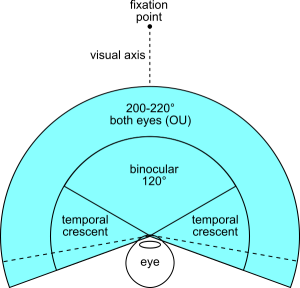Color, Depth, and Size
112 Binocular Rivalry
Learning Objectives
Be able to describe what binocular rivalry is.
Be able to give an example of under what conditions binocular rivalry may happen.
Binocular rivalry is a remarkable phenomenon of vision—two dissimilar images are presented simultaneously to each eye, and perception alternates between them. For example, if the left eye views horizontal lines and the right eye views vertical lines, an observer will report seeing one of the images for a few seconds, then the other, then the first again, and so on for as long as he or she cares to look (Wheatstone, 1838). You can experience this for yourself at www.psy.vanderbilt.edu/faculty/blake/rivalry/BR.html.
Binocular rivalry is a popular tool for studying perception and awareness, because perception changes even when the physical stimulus does not. For this reason, rivalry is championed as a useful tool for studying the neural correlates of visual consciousness (Crick & Koch, 1990). However, despite there being a rich literature on rivalry, there are few teaching and learning resources devoted to the subject. Carmel, Arcaro, Kastner, and Hasson (2010) address this in their video: How to create and use binocular rivalry.
The video begins with a brief description of binocular rivalry. It then provides a basic tutorial on the importance of stable vergence, because it ensures the two images fall on corresponding locations on the retina, as well as how it can be maintained during a rivalry experiment. For example, vergence can be maintained by surrounding each image with an identical frame of some sort, such as a simple or patterned border, and by placing an identical fixation point or cross in the centre of each image.
The video also discusses some of the advantages and disadvantages of different methods to induce binocular rivalry. For example, chromatic (e.g., red-blue, red-green, etc.) goggles are inexpensive (a few dollars) and can be used with fMRI, but are prone to bleed-through and require careful stimulus preparation to ensure that each image can pass through only one of the chromatic filters. The video provides the same level of detail for the mirror stereoscope and prism goggles.
Next, the video discusses the appearance of binocular rivalry. In particular, there is a neat demonstration of continuous flash suppression, a form of rivalry where a high-contrast image dominates perception indefinitely, and piecemeal rivalry, when patches of both images are perceived. Finally, the video discusses the distribution of dominance durations where time is plotted on the x-axis of a histogram and frequency is plotted on the y-axis, and that the data can be fitted with a gamma-like function.
Overall, the video is professional and easy to use: the descriptions are accurate, the described methods are clear, and the accompanying pictures and demonstrations are crisp. Indeed, the video achieves what its title promises, but it does at the cost of some omission of important features of binocular rivalry.
For example, the video mentions shutter and display goggles as methods to induce binocular rivalry, but fails to provide a discussion on the advantages and disadvantages of these techniques, and there is no discussion of the characteristics that affect rivalry. Also, there is no information about how to measure rivalry, such as by pressing one of two keys to report visibility of one of the images. This is especially surprising, because the video gives advice about the statistical tests to be used when analysing such data.
Despite these minor omissions, How to create and use binocular rivalry covers a good chunk of material. It is also accompanied by a paper in which some of the video’s deficiencies are redressed and in which there is a useful set of references. Although binocular-rivalry enthusiasts will be well-versed in the video’s content, it is unlikely that students and newcomers to the field will be, too. For this reason, I strongly endorse Carmel et al.’s (2010) video for teaching and learning purposes.

Provided by: PubMed
License: CC BY ND
References
- Carmel D. Arcaro M. Kastner S., Hasson U. How to create and use binocular rivalry. Journal of Visualized Experiments. 2010. p. e2030. (45) [PMC free article] [PubMed]
- Crick F., Koch C. Towards a neurobiological theory of consciousness. Seminars in the Neurosciences. 1990;2:263–275.[Google Scholar]
- Wheatstone C. Contributions to the physiology of vision.—Part the first. On some remarkable, and hitherto unobserved, phenomena of binocular vision. Philosophical Transactions of the Royal Society of London. 1838;128:371–394.[Google Scholar]

